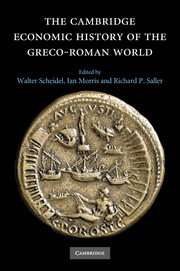Book contents
- Frontmatter
- 1 Introduction
- Part I Determinants of Economic Performance
- 2 Ecology
- 3 Demography
- 4 Household and Gender
- 5 Law and Economic Institutions
- 6 Technology
- Part II Early Mediterranean Economies and the Near East
- Part III Classical Greece
- Part IV The Hellenistic States
- Part V Early Italy and the Roman Republic
- Part VI The Early Roman Empire
- Part VII Regional Development in the Roman Empire
- Part VIII Epilogue
- Bibliography
- Index
- Map 1.1 The Mediterranean basin"
- Map 10.1 Greek and Phoenician trade in the period of the Persian Wars"
- Map 11.1 The Achaemenid empire"
- Map 12.1 Greece and Asia Minor"
- Map 15.1 The Seleucid empire"
- Map 16.1 Greco-Roman Egypt"
- Map 20.1 The Roman empire at the accession of Vespasian"
- References
4 - Household and Gender
from Part I - Determinants of Economic Performance
Published online by Cambridge University Press: 28 March 2008
- Frontmatter
- 1 Introduction
- Part I Determinants of Economic Performance
- 2 Ecology
- 3 Demography
- 4 Household and Gender
- 5 Law and Economic Institutions
- 6 Technology
- Part II Early Mediterranean Economies and the Near East
- Part III Classical Greece
- Part IV The Hellenistic States
- Part V Early Italy and the Roman Republic
- Part VI The Early Roman Empire
- Part VII Regional Development in the Roman Empire
- Part VIII Epilogue
- Bibliography
- Index
- Map 1.1 The Mediterranean basin"
- Map 10.1 Greek and Phoenician trade in the period of the Persian Wars"
- Map 11.1 The Achaemenid empire"
- Map 12.1 Greece and Asia Minor"
- Map 15.1 The Seleucid empire"
- Map 16.1 Greco-Roman Egypt"
- Map 20.1 The Roman empire at the accession of Vespasian"
- References
Summary
introduction
In the Greco-Roman world the household was the basic unit of production as well as consumption. This truism makes it imperative to understand how the household functioned through its life cycle, how property rights and labor participation were configured by gender and age. Too often in the past economic historians of antiquity have written with the implicit assumption that property owners and laborers were adult males. Even a rough understanding of ancient Mediterranean demography suggests that such an assumption is unwarranted: women and children were important potential sources of labor and, in some legal regimes, substantial property owners.
The centrality of the household and family in the ancient economy is reflected in the most influential Greco-Roman work on the “economy,” Xenophon’s Oeconomicus. Written by an Athenian in the fourth century bc, this treatise of advice on estate management was read and cited as a source of wisdom for more than two millennia. The work has been set aside as “not modern economics” (which it is not), and has been characterized as moral ideology (which it is). But neither point should obscure the fact that its basic theme, the gendered division of labor, was fundamental in household production and consumption.
Keywords
- Type
- Chapter
- Information
- The Cambridge Economic History of the Greco-Roman World , pp. 87 - 112Publisher: Cambridge University PressPrint publication year: 2007
References
- 16
- Cited by



